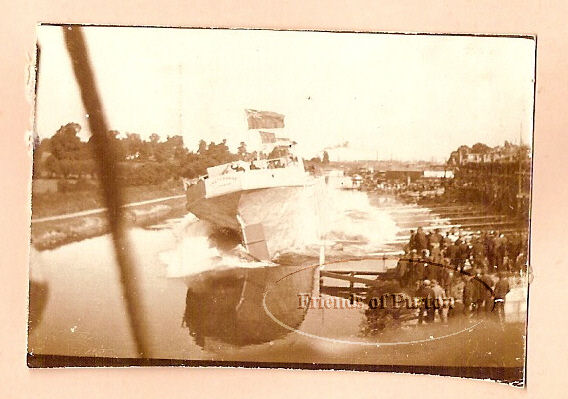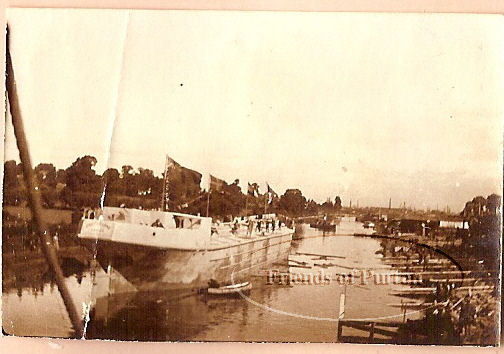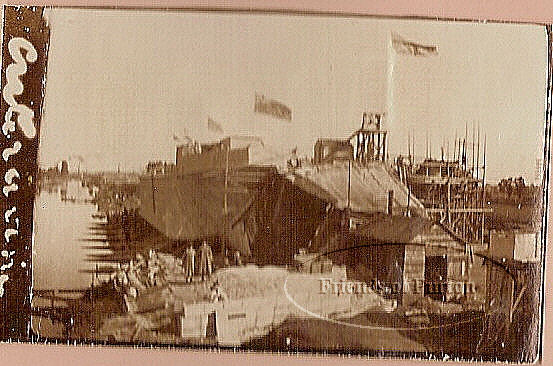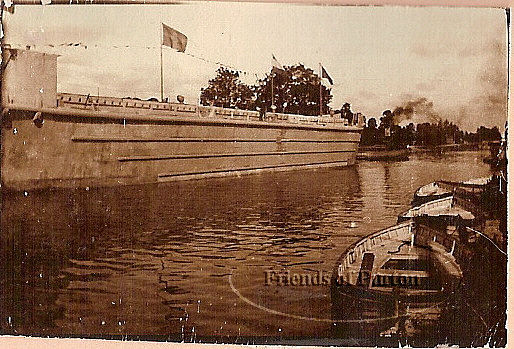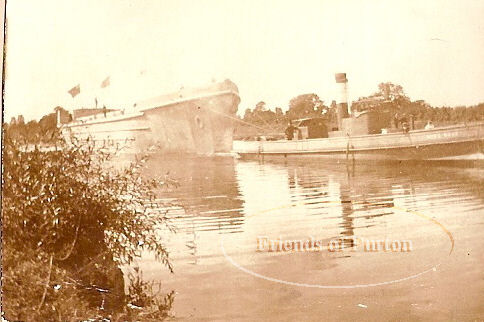FCB 52
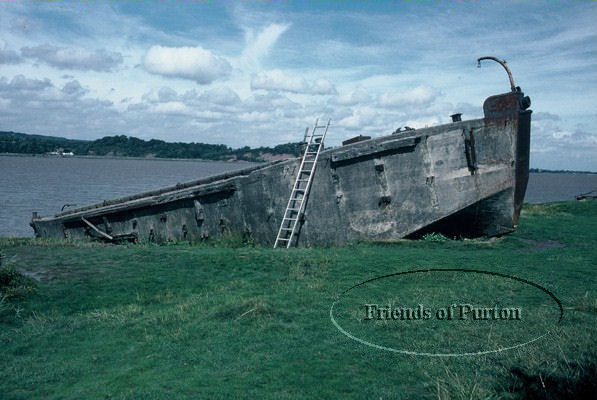
FCB 52
The remains
Significance
Original considered unworthy of research by many, Purtons eight Ferro Concrete Barges (FCB) must surely be the most overlooked and understated enigma of the entire collection and yet despite this they continue to form Purton most enduring and visual representation of mans continual struggle to conquer the waves come what may.
Born out of necessity, these unique craft were considered experimental during their construction under licence by Wates Building Group Ltd of Barrow in Furness in 1941 and were seen as an effective method to bolster the nations levels of port lighterage and floating storage facilities without the need to draw upon the nations iron and steel reserve which were better placed to serve the war effort during this time of world hostilities. Indeed once constructed, FCBs were issued to the all of the U.K.’s major Port Authorities with the intention of supplementing the capacity of existing grain, oil or food stuff storage facilities within the Port hinterland.
Originally conceived and designed by Messers L.G. Mouchel & Partners Ltd., in conjunction with Mr E. F. Spanner M.I.N.A., Purtons concrete fleet originally formed part of an ambitious plan by the Ministry of Shipping to construct a flotilla which was both cheap to construct whist having the advantage of being prefabricated and thus able to be assembled and dispatched quickly. As such , some 273 FCB‘s were constructed using 126 pre-cast two foot panels formed by from a dense concrete slurry over a pre formed metal reinforced frame which in turn reduced the quantity of metal required from 56 ton to 18 ton. These sections were then bolted together using 42 pre-cast rib section with the seam being waterproofed using a rapidly setting cement mix.
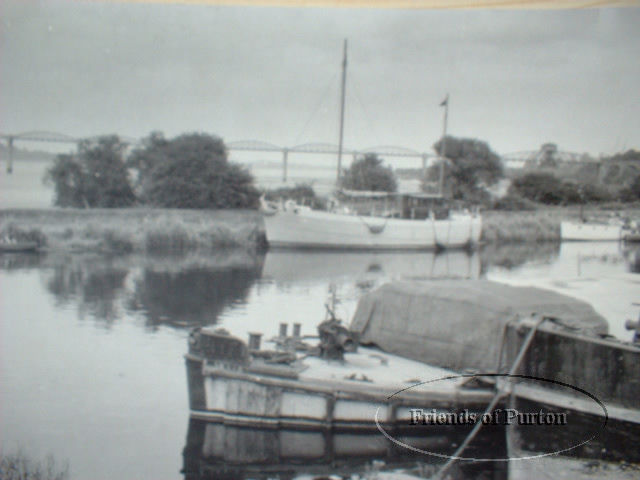
There were principally two types of FCB design, one being the more common 3 inch swim head design for use in tidal reaches and the much rarer 2 inch stem head construction, which were original designed for the calmer waters of harbours and inland waterways namely the Manchester Ship Canal. It is therefore important to note that Purtons eight stem head FCB.’s form a substantial collection of only 39 such built FCB’s within the U.K.
Not withstanding, it is now understood that Purtons historic FCB stem head design was effectively later used in 1944 as the blue print for the concrete pontoons of the floating roadway which served the Mulberry Harbours employed during the decisive battle for the beaches in Normandy.
More recently Purtons FCB’s unique construction and their vital work for war effort has been formally recognised by their inclusion on the Historic Ship Register, which continues to herald the finest examples of British shipbuilding, technical innovation and maritime heritage the country has to offer
And so they lie abandoned but not able to be forgotten
Specification
FCB 52 |
|||||||||
LPB identification number |
16 |
DRM identification number |
N/A |
AJP identification number |
15 |
||||
Source |
(LPB)(JC)(JP)(JPr)(DF)(DW)(DJW)(AJP) |
||||||||
Name |
P.O.R |
Description |
Dates |
||||||
FCB 52 |
N/A |
Ferro Concrete Barge |
1941 - c. 1965 |
||||||
Official number N/A |
Code N/A |
||||||||
Builders: Wates Building Group Ltd – Barrow in Furness |
|||||||||
Dimensions |
Length 84ft |
Breadth 22.6ft |
Depth 8.1ft |
||||||
Tonnage – (1941) Gross 332 ton loaded Net not recorded B.D |
|||||||||
Engines None |
By N/A |
H.P. N/A |
|||||||
Beached date |
C. Autumn 1965 |
||||||||
Beached by |
Resolute Capt Oliver Powell, Jimmy Common, Bob Green, Dick Woodward |
||||||||
Recovered |
28th March 1990 |
||||||||
Recovered by |
Freight Mover Capt Jimmy Common, John Perkins, Jack Caddy, Dougie Griffin |
||||||||
Miscellaneous |
Purtons FCB’ have no reference in any Mercantile Navy List |
||||||||
First Owners |
Fred A. Ashmeads & Sons Ltd, Bristol |
||||||||
Changes |
George Thomas Beard, Gloucester |
||||||||
Historic overview
Plato once stated “Necessity is the mother of invention” how right he was.
Due to wartime embargo on information, very little concise information regarding the birth, use and eventual sale of Purton concrete fleet is difficult to obtain. As such the following information regarding the early years of these impressive beasts’ remains littered with conjecture and at times urban myth. Never so much so that locally, many believe that Purtons eight impressive concrete goliaths were originally the result of local labour force and a pronounced Gloucestershire determination to succeed in times of hardship.
These flames are further effectively fanned as many still recall that Gloucestershire men had once been engaged in the construction of several concrete giants at the Hempstead slips, in an effort to thwart the hardships of the post 1914 -1918 conflict and the real desire to provide much needed sea going vessel, in time of limited traditional ship building material.
What is of course is true that such an operation did indeed take place in the form of the Gloucester Ferro Concrete Ship Building Co. Ltd, who in 1918 employed a huge workforce to design build and launch six such vessel of the Creterock Class of concrete constructed lighter. Research has shown however that Gloucester’s concrete vessels were eventually dispersed around the country and beyond.
Launch images courtesy of Alistair Maclaurin
No, current research would suggest that the Purton eight, based on the employed construction method, design features and available secondary literature, are rather best suited to the Barrow in Furness yards of the 1940s as built under licence to Waits Building Group Ltd. and all constructed as part of then ongoing war effort under the experimental Ferro Concrete Barge (FCB) programme.
What is known however, is that the Purtons eight were originally given a number and issued to the Port of Bristol Authority who in turn re- issued them to established Bristol lighterage company Fred A. Ashmead & Son for use in the dry cargo industry namely the storage of wheat and grain food stuffs.
Once again and due in part to the war embargo and in part to the loss on mass of Fred Ashmead held records due to a fire in the companies archive very little is known about the activities of these unique craft whilst in the port, but what has been gained via personal recollection of former crewmembers, the FCB’s were both cumbersome to steer and unfit for the long-term storage of grain due to the porous nature of concrete.
As a result the concrete fleet having occasionally made the northward journey into the Severn, were sold to Gloucester lighterage company G. T. Beard (1929) Ltd. and arrived for duty on the Gloucester to Sharpness Canal in July and October of 1946 for general cargo duties. Once here, it was soon re-established that their infamy of poor handling and damp condition had resurfaced and the fleet was soon put to work caring the occasional timber deals condiments for Gloucester timber merchants or were often as not to be found in less active locations of Sharpness Dock and adjacent Old Arm to act as temporary mooring for larger more agile craft. (ENTER JOHN PERKINS FCB LOG BOOK HERE)
The 1950s saw Purtons concrete fleet change hands into the employ of Benjamin Cooke, who following his retirement from stevedoring c. 1955 went onto become Lord Mayor of Gloucester. Following this time, little is formally recorded of Purton concrete fleet, however it is believed that they passed into the ownerships of the Nationalised British Transport Commission for permanent use on the Sharpness to Gloucester Canal.
http://en.wikipedia.org/wiki/British_Transport_Commission
1963, and following the Transport Act 1962, saw the responsibility of the canals once again transfer to the newly formed British Waterways Board (BWB) more latterly the modern day British Waterways. http://en.wikipedia.org/wiki/British_Waterways
It was during austere time of change and in light of a steady down turn in trade coupled with spiralling maintenance costs (1962 saw many of the FCBs being refitted with new winches and timber ceiling boards, that the burdon became too great and Purtons intrepid eight eventually took up their final resting place, FCB 75 being the last to arrive in 1965.
The Beaching Process as recalled by Arthur ‘Dick’ Woodward former British Waterways Suction Plant Operator 1950 - 1988
Dick assisted in the beaching process from 1947/8 through to the end of his career with British waterways in 1988. Further and due to his location on the nearby Suction Plant as Plant Operator/maintenance, he was able to familiarise himself with the daily events of the area. It is his understanding that British Waterways were paid a small fee for accepting Board of Trade Licence failures from their owners with the view to beaching them in strategic places along the narrow strip of land between the Sharpness and Gloucester Canal and the adjacent fast flowing River Severn.
Furthermore due to the vast scouring forces which were produced as a direct result of daily Suction Plant operation to remove dredging at this point. It was also apparent that the locally named sluice gully was rapidly being eroded and thus in need of protection. This was achieved by placing redundant vessels in the vicinity of the gully. (See Barry and FCB No.52). Dick further remembers that at various times British Waterways actively let it be known that they would accept any such condemned vessels that could be used as a breakwater.
Dick went on to outline a typical beaching operation:
“We were paid 17 hours per vessel and could finish when we finished, however you had the option to return to your normal daily duties and thus earn some extra money” The operation would involve a tug and crew bringing round the vessel to be beached from Sharpness on a full tide. At this time the condemned vessel would be manned by a helmsman and deckhand whose role was to steer the vessel and handle the mooring ropes. Upon the selection of the abandonment site the tug would provide momentum by steaming from the middle of the river towards the chosen section of bank and cast off at the last minute in order to prevent running aground itself. The condemned vessel would then, under its own momentum, be steered up onto the bank. At this point ropes would be attached to backside trees or stakes and the vessel using her own winching gear would be hosted further up the bank and thus to its final resting place. Once this was achieved the beaching party would remain with the condemned vessel until the tide retreated to a safe level that would allow large holes to be cut into the hulls”.
FCB 52 - The identification begins
Once beached, FCB 52 identity very quickly became somewhat of an enigma on Severnside and as such her eventual re- identification can be said to typify the detailed process which has been applied in order to re-establish a connection with our long since lost maritime past.
Following her removal on the 28th March 1990 for use as an exhibition in the Barge Arm of the nearby historic Port of Gloucester, this concrete lighter has continued to baffle maritime researchers and intrigue the general public alike. Initially heralded as a monumental event, by Gloucester’s National Waterways Museum, whose recovery was programmed to reignite the cities long since diminished connection with a proud maritime past. Now sadly, in lee of the razzmatazz and the marching bands, this fine example of mankind’s ingenuity has more latterly been exiled to the very corners of our memories, again alone forlorn and forgotten. And yet it could have been oh so different for the 28th March 1990 did indeed signal the beginnings of her rebirth through deliberation in an attempt to unravel her past and thus establish her true identification.
Upon her recovery in 1990 the letter B and the number 5 could clearly seen in large white symbols on the port hand quarter via the many photographs and video recordings of her momentous re-launch. To this end members of her recovery team initially identified her as B5, only to re-identify her some time later as B56. The author is unclear as to how this original identification was reached or indeed how the identification process took place, but what is clear is that typically members of this unique fleet were originally identified by a letter B meaning simply Barge or FCB (Ferro Concrete Barge) following by a number signifying her position in the launching sequence 1 – 273.
Furthermore what is known, of the two distinct designs be it stem or swim head, the B prefix was often retained for the identification of covered tank design of the oil/petrol carrying concrete barge fleet, typified by its concrete hatch cover and distinctive goose neck vents. From this, one can reliability suggest that Purtons fleet with their more common open cargo holds, would suggest that they are of the FCB prefix classification. This of course is of little significance, albeit for formal entry within fleet registers or indeed in legal paperwork, as all concretes very rarely had it prefix annotated on the vessel its self, more over identification was aided by having the vessel distinct number painted or embossed on the fore chain plate. Armed with this information, the author is therefore reasonably confident that B5 identification may have been applied at some later date rather than at the time of her launching, possibly to denote a specific mooring or berth identification whilst used as a mooring pontoon within the dock.
Regardles of this 2002 saw Purton’s recovered FCB being formally recorded as F.C.B. 56 by the National Register of Historic Vessels (National Maritime Museums). Although factually incorrect, this remains of little criticism of the respected NRHV data base, as they merely record data provided first hand from the current owner and have more latterly to their full credit, corrected the Certificated Entry 1859 in light of a comprehensive review of the available evidence by the Friends of Purton in 2007.
Hindsight is indeed a wonderful thing for upon reference to the 1951 Mercantile Navy listing, the author is confident that Purton’s recovered FCB is not as suggested B or FCB 56 as F.B 56 Official number 183771, 106 tonnage, Built Barrow in Furness 1941 was registered for Liverpool Lighterage Co Ltd of 5 Chapple St. Liverpool and thus is not to be found on Severnside. More likely, she may be one of three concrete lighters which have been recently rediscovered in a in filled tributary at near by Runcorn.
Either way, what has been firmly establish is that Purton’s concrete were originally shipped to Bristol c.1941 and were put to work in the general cargo fleet of Fred Ashmead and Sons. At this time Bristol port records clearly record eight concrete lighters being present. These include FCB, 51, 52, 67, 67, 68, 76, 77 and 78. This fact is further born out via the Gloucester Port arrivals (D2460/4/5/1 – 4) which record the initial arrival of the concrete fleet thus:
Vessel |
Date |
helm |
From |
To |
Cargo |
FB 67 of Bristol (lt) |
18.07.1946 |
Beard |
Avonmouth |
Glos |
MT |
FB 68 of Bristol (lt) |
18.07.1946 |
Pinkney |
Avonmouth |
Glos |
MT |
FB 75 of Bristol (lt) |
18.07.1946 |
Collier |
Avonmouth |
Glos |
MT |
FB 76 of Bristol (lt) |
18.07.1946 |
Woodman |
Avonmouth |
Glos |
MT |
FB 77 of Bristol (lt) |
19.07.1946 |
Francis |
Avonmouth |
Glos |
Linseed |
FB 78 of Bristol (lt) |
19.07.1946 |
Haywood |
Avonmouth |
Glos |
Linseed |
FB 51 of Bristol (lt) |
04.10.1946 |
Beard |
Northwich |
Glos |
Timber |
FB 52 of Bristol (lt) |
04.10.1946 |
Beard |
Northwich |
Glos |
Timber |
It was therefore an important break though to discover the working diaries of John Perkins who whilst employed as a lighterman on the Gloucester to Sharpness Canal and River Severn between 1955 -1969 maintained an accurate record of his time. This was principally conducted in order to support his claim for legitimate payment whilst at the helm of various vessels and would be duly submitted to the pay clerk the as evidence of hours worked. Further and more importantly John accurately recorded his transient movement throughout the fleet, in doing so he gives us a rare insight into the working of the dock whilst recording the last days of Purton eight concretes lighters F.C.B. 51, 52, 67, 68, 75, 76, 77 and 78.
From this we can further cross reference the Gloucester Port Book entries of July and October 1946 and more latterly with David R Macgregor’s recorded visits and research of the 1950s and again during the 1960s. As a result, we can confirm the F.C.B. fleet listing and establish FCB 67, 68, 76, 77 and 78 their eventual abandoned during the early part of the 1960s.
Finally, the arrival and sketching of a young David Wheeler in 1965 have proven pivotal, as David accurately recorded F.C.B. 75 being beached across his favourite vessel Monarch, whilst he vividly recalls the existence of F.C.B. 51 as being “freshly deposited” in June 1965. That said David goes on to note that by October 1969 the same vessel was only recognisable as “only her bows and stern gunnel remain visible, due to extensively silting.” It was during this final visit that David formally identified the removed F.C.B. by recording her hand painted number which was still visible on the soon to become rusty forward chain plate. He further confirmed this by annotating in his words his ‘Crude’ 1969 draw map “F.C.B. 52 located just south of the suction plant”.
So where is Purtons illusive eighth concrete lighter?
Should one visit the site, not only are visitors be amazed at the size of these concrete goliaths but one very quickly establish via Friends of Purton installed plaques, that FCB, 67, 67, 68, 76, 77 and 78. are currently positioned to the north of the site. This fact was initially established during the visit in 1963 by emanate maritime historian David R. MaGregor, who meticulously recorded photographed and located these vessels in light of their still visible chain plate numbers. Sadly however David made no reference to FCB 51 or 52, which it is believed, were still afloat in service at Sharpness Docks. This did however effectively narrow the re-identification of B5 to one of only two possible candidates FCB 51 or 52!
It was around this time in the 1960s, that Dock Company Bank Foreman, Bob Greene noticed a rapid onset of bank erosion that was affecting the area known as the Gutter to the south of the site. As a result he conducted a series of rudimentary experiments using Hazelwood stakes being located along the existing bank, in order to gauge the loss of river bank. Once established, the findings were latter feed back to Dock Company Superintendent, Donald Fowler, who very quickly thereafter decreed that the ‘Gutter be shut off to the ebbing tide by positioning barges across or into the deep channel’.
In line with this, the author was advised of the possibly that as many as three concrete lighters were originally ear marked to be abandoned in or around the head of the gutter, but has as yet been unable to substantiate this claim at this time. What is however now clearly understood via long time Friends of Purton member and one time Purton site recorder, David Wheeler, that the gutter was indeed closed of with the use of one concrete lighter, which he personally saw and as previously recorded in detail during his 1965 visit as ‘concrete lighter buried up to gunnels in channel to the south of the site’.
As a result the author remains indebted to David, for forming his boyhood chart, which would, with time, eventually provide the key component in identifying Purtons illusive FCB. Little did young David realise the significance of his flitting pencil strokes as he formed his simplistic schematic diagram all those years ago. Never could he have realised that he would eventually become the finite source of information that would effectively locate and record the last resting place as he put it of ‘concrete lighter 51’. It is therefore principally due to the process of elimination, good fortune and steadfast detective work that FCB 52 was eventually correctly identified and reunited with her past.
Recent visitor who often come the site will eventually stumble across a distinctly boat shaped hole and yet very few will stop and think or even recognise that they are standing alongside the last resting place of one of Purton’s best kept enigmas, that said the Friends are scheduled to erect a plaque to mark the pasting of one of our own – recovered and quietly waiting forlorn once more abandoned barely afloat simply waiting.
So there we have it, it was as the result of the primitive hand sketching and inquisitive mind of a child, that led to the modern day re-identification of F.C.B. 52, whose story has only now come full circle and, who, I’m sure, will continue to dominate Gloucestershire maritime history for many years to come.
Lessons from the Past - Don Fowler - Sharpness to Gloucester Canal Superintendent – 1937 - 1975 F.C.B 52
Donald recalls that he was far from pleased to hear of the proposal by the Waterway Museum to remove FCB No. 52 from its location on the bank at Purton in 1990 and choose to attend the recovery in order to make his feeling known to the then curator Tony Condor. This was based on his understanding that the gully and adjoining river bank at this point were prawn to serious scour as a result of the vast quantities of water which was utilised during normal Suction Plant operations, which could last anything up to three days continuous service in times of flood. Furthermore Donald recalls that he had personally requested that the former Ben Cooke owned FCB No. 52 be beached at this point in order to address the bank erosion as a result of these daily operations. Donald also noted that hydrostatic forces within gully had long since been recognised as his predecessors had attempted to stem the scour by beaching a timber lighter on the bank adjacent to the north face of the gully and a former timber wreaking vessel and stone groin diagonally down stream. The barge however had with time toppled into the gully and both vessels had, as a result of the continued abrasive forces of solute mud and high pressure water emissions from the Suction Plant, been greatly dissolved in situ by the time the beaching of FCB No 52 in c.1964
Look to the future
Dear Mr Barnett,
I am emailing you because some structural engineering contacts of mine in the UK have suggested recently that I should be interested in the wrecks of the concrete ships/lighters at Purton. I found (several) references to you on the web and from the information there it seems that you are obviously a key person with whom I should attempt to establish contact.
In brief, I am an academic with research interests in the durability of reinforced concrete structures and in the rate at which reinforcement corrosion occurs over long periods of time. As you may have observed, there are many reinforced concrete structures that have only relatively short useful lives
before reinforcement corrosion renders them unsafe. But others appear to be surviving quite well over long periods of time – the over-riding question is why this is so. At present the engineering /scientific understanding of why this occurs is incomplete, to put it mildly.
I am likely to come to the UK in April to look at some other older concrete structures and since looking at your website and the newspaper article that prompted my British contacts, it may be that the Purton reinforced concrete wrecks could add to the overall scientific picture that I am currently building up. It is for this reason that I would like to ask you a small number of questions to help me come to grips with what is or might be available, prior to my coming over. (I note you are scheduled to run a conducted tour on 19 April).
Q 1 – the age range of the concrete vessels.
Q 2 – do you know, or can we discover, where the concrete vessels were built,
and the likely sources of the materials used, particularly the water, sand and
aggregate (stones) used in making the concrete?Q 3 – are there any photographs of the vessels, close enough to show any
evidence of reinforcement corrosion. Where would I find these? If not, are the
vessels accessible for me to take photographs?
Q 4 – I understand from your website that the wrecks are currently not heritage
protected. Do you know if there are any limitations on access and detailed
examination (microscopic, chemical)? If so, would you know whom I should contact
to attempt to gain access?
I hope you will be able to help. You can check me out through a Google search on my name or the University of Newcastle, Australia.
Thank you in anticipation for any help or advice you may be able to offer.
Yours sincerely,
Rob Melchers
Robert E Melchers | Professor of Civil Engineering | The University of
Newcastle, Australia | T +61 2 4921 6044 | F +61 2 4921 6991 | M 0415 845 867 |
Dear Professor Melchers
With regard to your recent request, I write to advise you that I am more than happy to answer any questions you may have and as such I am willing to help in any way that I am able.
As a result kindly find information as requested
Q 1 – the age range of the concrete vessels.
Answer: 1941
Q 2 – do you know, or can we discover, where the concrete vessels were built,
Answer: Barrow in Furness on the North West Coast of England
and the likely sources of the materials used, particularly the water, sand and aggregate (stones) used in making the concrete?
Answer: Sadly I am unable to provide any local knowledge but I am able to advise that the clasts appear to be rounded marine moran and not angulated. That said I will make some further investigations in due course.
Q 3 – are there any photographs of the vessels, close enough to show any evidence of reinforcement corrosion.
Answer: Find enclosed for advice further and I will obtain
Where would I find these? If not, are the vessels accessible for me to take photographs?
Answer: Access can be obtained
Q 4 – I understand from your website that the wrecks are currently not heritage protected. Do you know if there are any limitations on access and detailed examination (microscopic, chemical)? If so, would you know whom I should contact to attempt to gain access?
Answer: Sadly as with all privately owned land the site has limited access for sampling operations however if you were to provide as much information as possible including method statements and H & S considerations, I will endeavour to complete the necessary paperwork and complete an application to conduct trails, on your behalf.
Furthermore the site is part of a SSSI and therefore all flora and fauna is protected in law. As a result I am happy to discuss with Natural England and obtain the required permits to work and in force for your visit during the Spring of 2009
With fondest regards
Paul Barnett
FCB 52 – Purtons sole survivor!
Historic images
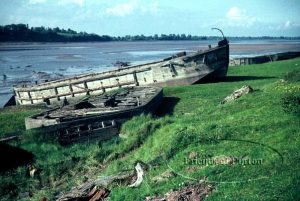
FCB 52 - 1967
Abandoned at Purton 1967, the Norman Andrews Archive
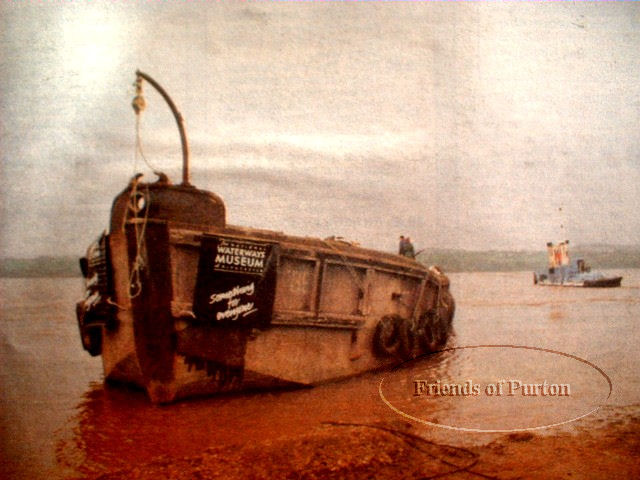
FCB 52 - 1990
The quiet before the storm: recovery 1990 The Donald Fowler Archive
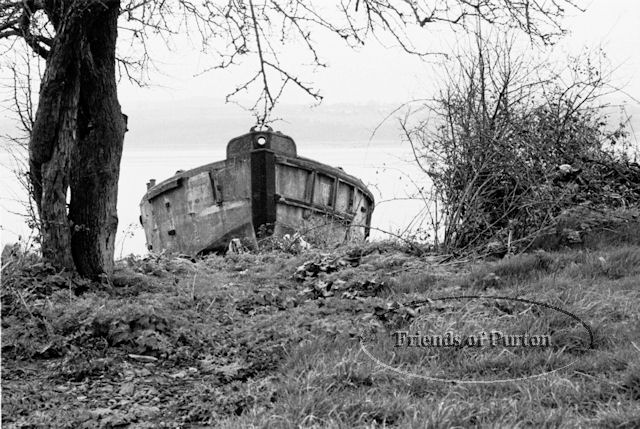
FCB 52 - 1987
Bows in black and white c. 1987 The Phil Booth Collection
Recent images
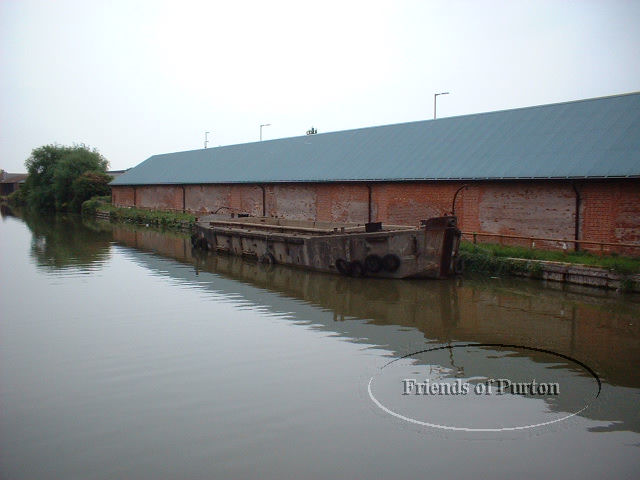
FCB 52 - 2002
Alone at the ‘Saltings’ Hempsted Bridge 2002, The L. P. Barnett Collection
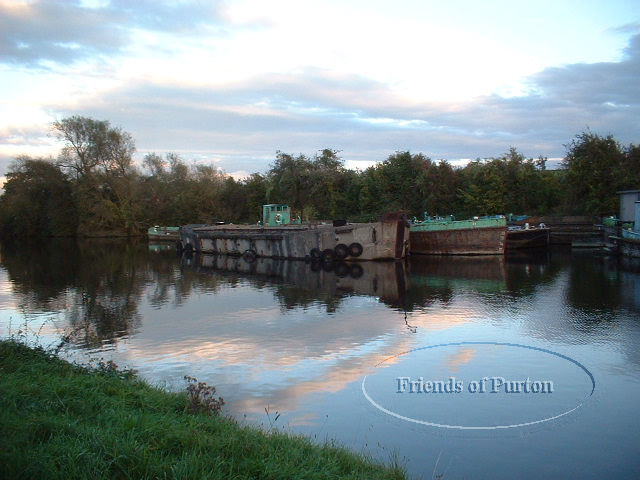
FCB 52 - 2004
Alone at last Marshfield 2004, The L. P. Barnett Collection
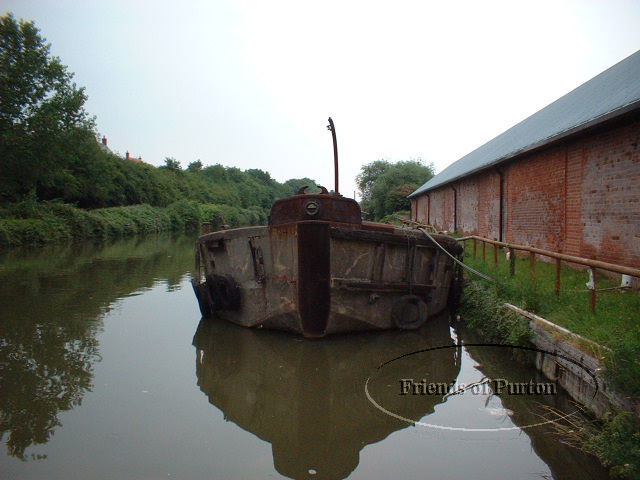
FCB 52 - 2002
Bow 2002, The L. P. Barnett Collection
Lloyds register
Not registered
Mercantile register
No reference in any Mercantile Navy List, however F.B 56 Official no. 183771 106 T Built Barrow in Furness 1941 for Liverpool Lighterage Co Ltd of 5 Chapple St. Liverpool (1951) and thus not to be found on Severnside
FCB 52 ancillary information
Not located at Purton in Rob Schopland 21st September 1957
FCB original arrival at the Port of Gloucester D2460/4/5/1 - 4
FB 67 of Bristol (lt) |
18.07.1946 |
Beard |
Avonmouth |
|
MT |
FB 68 of Bristol (lt) |
18.07.1946 |
Pinkney |
Avonmouth |
|
MT |
FB 75 of Bristol (lt) |
18.07.1946 |
Collier |
Avonmouth |
|
MT |
FB 76 of Bristol (lt) |
18.07.1946 |
Woodman |
Avonmouth |
|
MT |
FB 77 of Bristol (lt) |
19.07.1946 |
Francis |
Avonmouth |
|
Linseed |
FB 78 of Bristol (lt) |
19.07.1946 |
Haywood |
Avonmouth |
|
Linseed |
FB 51 of Bristol (lt) |
04.10.1946 |
Beard |
Northwich |
|
Timber |
FB 52 of Bristol (lt) |
04.10.1946 |
Beard |
Northwich |
|
Timber |
Bristol maritime enthusiast Jim Crissup identified the Dursley Reg: F. A. Ashmeads & Son Ltd
as being located during his 1986 survey
Gloucestershire Sites & Monuments record
P. A well preserved barge
Robin Criag maritime author and researcher advised Dursley as exstant in 1953
Genealogy
George Thomas Beard – Gloucester owner
Ben Cooke – last Gloucester owner
Donald Fowler – Beaching Superintendent
Capt. Oliver Powel – beaching tug Resolute Skipper
Charlei Langford – Beaching crew
Jimm,y Common – Beaching crew
Dick Woodward – beaching bank party
Johnny Wathon – beaching bank party
Bill Deaton – beaching bank party
Bunny Hunt – beaching crew
Bob Green – beaching helmsmen
Jimmy Common – recovery Tug Master – Freight Mover
Jack Caddy – recovery crew
John Perkins – recovery Helmsman
Dougie Griffin – Alaska 1 – pilot cutter safety boat
Tony Condor – Gloucester’s National Waterways Museum – Curator
David MacDougall – Gloucester’s National Waterways Museum Assistant Curator
Analogue transcripts
Jimmy Common - Tug Skipper BW 1960 c.1980 & Vindi Boy
E. Position of a concrete barge, formerly recorded and no longer on the site. This is presumably the barge removed to Gloucester in recent years.
Gloucester sites & memorial records
PURTON: KEY TO PLAN OF BOAT REMAINS Reference A. J. Parker (1998)
38. Barge. Worked as dumb (no motor) barge until c1963.
Hugh Conway Jones - Author
The FCB at Gloucester -My notes say it is number fifty something, so I have no problem with it being No 56. It is likely that David McDougall has provided that information. To be sure of the source, check with him.
David MacDougall
Gloucester’s National Waterways Museum Assistant Curator
Position of a trow observed in the mud when No.15 B5 (FCB 52) was removed.
Janet Presley Slides
Friends of Purton
FCB 52 (51) afloat 03.09.65
A.J. Parker
PURTON: KEY TO PLAN OF BOAT REMAINS Reference A. J. Parker (1998)
15. Position of concrete barge, now removed to Gloucester Docks.
16. Position of a trow observed in the mud when No.15 was removed (MacDougall).
John Perkins - Lighterman on the Gloucester to Sharpness Canal and River Severn - 1955 to 1969 FCB No.52
John once again took to the Severn as the skipper of FCB No. 52 in 1990 as the vessel was recovered from the Purton bank using the tug Freight Mover under the command of Jimmy Common and crewed by little Jack Caddy (JP was actually the engineer and relief skipper of the tug during the recovery operations). He then transferred on to FCB No. 52 as it waited to lock up into the S & G Canal, in order to helm the vessel to its new home at the Waterways Museum in Gloucester docks. He had been chosen for this prestigious role as it was widely understood that he was expertly qualified and had for many years skippered various river and canal vessels including these legendary difficult to steer concrete lighters. Ironically this had included the FCB No. 52 in her trading days.
Indeed it was as a result of John’s hard won knowledge that the once FCB No 52 had finally returned to the calm fresh waters of the cut, she was tethered on a short tow rope to the Freight Mover, whilst ensuring sufficient distance between the tug and her charge to provide the required volume of water and thus prevent loss of steerage. John noted that it could take 8 hours to reach Frampton in a concrete lighter.
John whilst as the skipper of the FCB No. 52 remembers that in order to remove her from the bank it was necessary to remove all the silt accumulated silt from within and around the vessel and then carry out repairs to the hull which had been holed as a part of the beaching process. This was achieved with the use of shuttering that allowed concrete to be poured and thus form a plug to seal the holes. This achieved, the FCB No. 52 was towed to Gloucester Docks and located within the barge arm to form an exhibit at the Waterways Museum.
The National Register of Historic Vessels (National Maritime Museums)
State that Gloucester Maritime Museum have the FCB No.56, (now been removed to the below Hempstead Bridge due to unsightly appearance) which was removed from the Purton bank in 1986. Furthermore it states that the FCB no. 56 was built in 1940 as a 80ft concrete lighter. Other examples include the FCB No. 18 at Ellesmere Port Museum Cheshire built in 1944 as an 24.38m ammunition lighter and FCB No. ? currently at Danhead Creek, Kingsnorth on the River Medway, Kent, which is a laid up example of a concrete fuel lighter also built in 1944
Len Williams
Port of Bristol Warehousing Manager 1932 – 1976
Len does not recall the concretes ever being at Bristol or Avonmouth, however he states that he came back to work at Avonmouth Docks in 1946 following active war service and thus believes that they may have already been transferred to Sharpness.
David Wheeler - Site recorder
F.C.B. No.52 not located in June 1965
Dicky Woodward - British Waterways as Suction Plant Operator
Other vessels of note
Dick noted a further 5-6 concrete lighters had been beached in the gutter however can no longer be seen as they have become completely covered as a result of deposition. The operation was carried out thus “We dropped them in the gutter, hit a hole in them which in comparison to wooden vessels was an easy task. The vessels were then flooded at each tide and gradually filled up and never moved again. Evidence to support this can be found by the reference to the buried FCB No. 51 (see David J Wheeler).
Note at a later time and upon the discovery of DJW evidence Dick was asked had he or anyone else ever removed a lighter except for the No. FCB 52 by the Waterway Museum. The answer to this was no not even to reposition them.
Britton Ferry situated below concrete taken to Gloucester, long ways to the bank next to Monarch
Ref. To concrete F.C.B. 51 at lower position i.e.” we dropped 5 -6 in the gutter”

